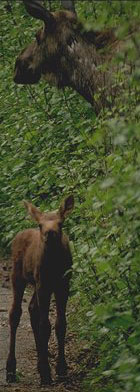Home | Meet Details | Writing | Graphics | Favorites | CDs | Paperbag
![]() 507 E Street, Suite 212
507 E Street, Suite 212 ![]() Anchorage AK 99501 (907) 276-0353
Anchorage AK 99501 (907) 276-0353 ![]()
 Moose sightings guaranteed at Chena
Moose sightings guaranteed at Chena
Remember the good old days, when a good prime rib dinner could be had for less than $18? Or how about home-cooked meals like pork chops, with salad, soup, baked potato, fresh vegetables and fresh-baked bread? You'll find that out at the resort, too. For $12 in the "off season" of summer.
The most expensive wine in the house at Chena Hot Springs was $36 (a 1983 Piesporter Treppchen Spatlese from Germany), and most vintages range from $12 to $14. Cabin and lodge rates also are reasonable enough to make a trip to the resort feasible even for families.
But I digress: Back to the springs.
Felix Pedro, the guy who discovered gold in the Fairbanks district and created the purpose for the city to arise in the first place, discovered the springs in 1905 while prospecting for the yellow stuff. George Wilson homesteaded the area a year later, and it quickly became a resort community for the miners and residents of the Interior. Use of the resort fell off when the Gold Rush subsided, and it's passed through four owners' hands since 1953. Over the last decade, the resort has flourished (especially in winter).
The U.S. Geological Survey, University of Alaska Fairbanks and others have studied the springs over the decades since 1917, but no one knows their true thermal capabilities for certain.
Geologists do know this, however: The original springs emerged from Cold Creek (a curious name, considering); they issue from the ground into today's man-made pools at 157 degrees, Fahrenheit, and they're heated by molten rock in the earth's crust. Heat from the magma is transferred to surface rocks, which heat up streams like hot pavement in Manhattan in July. By the time the hot spring water is married with well water at the resort, bathers in the pool are enjoying a swim in naturally heated water of 100 degrees. The Jacuzzi hot tub invigorates with an effervescent warm temperature, and the mineral baths soothe the soul at 110 degrees,
Hot springs such as those at the resort have long been sought for their medicinal qualities. These springs are reported to be soothing for arthritis; an elixir for what ails the stomach; and a cleanser of impurities that plague the skin and muscles.
Pertinent constituents of these springs are silica, sodium, bicarbonate, and sulphate.
They are, however, strange. Out on the porch by the pool, steam rises from the natural ponds (too hot for swimming), and part of the creek meanders at your feet. A distinct odor of sulfur emits from these ponds. The naturally occurring chemical compounds and elements combine to create an eerie, undulating, vegetative mat that peels off the subsurface rocks. No fish live in this water, but the moose love whatever is growing down there in the creek mud. One bull put up with a score of clicking photographers just 10 feet away to have his evening dinner. (More than 30 moose inhabit the immediate area, which the resort's owners have placed off limits to hunting.)
In between immersions in the people-water, visitors can stroll well-tended grounds packed with mining equipment memorabilia; take a nature trail stroll; pitch horseshoes; play badminton; sunbathe in hammocks; or chat under the patio umbrellas.
Visit the springs in winter, and spectacular displays of the aurora borealis appear virtually each clear night
A day or two at a hot springs in the Arctic is just what the doctor ordered after a long trip on the road.
--Sally J. Suddock
Visit these websites for more travel news:
State of Alaska Tourism Marketing Council: travelalaska.com
Anchorage Convention & Visitors Bureau: anchoragecvb.net
Fairbanks Convention & Visitors Bureau: fairbanks.polarnet.com
Chena Hot Springs: chenahotsprings.com
Home | Meet Details | Writing | Graphics | Favorites | CDs | Paperbag
![]() 507 E Street, Suite 212
507 E Street, Suite 212 ![]() Anchorage AK 99501 (907) 276-0353
Anchorage AK 99501 (907) 276-0353 ![]()